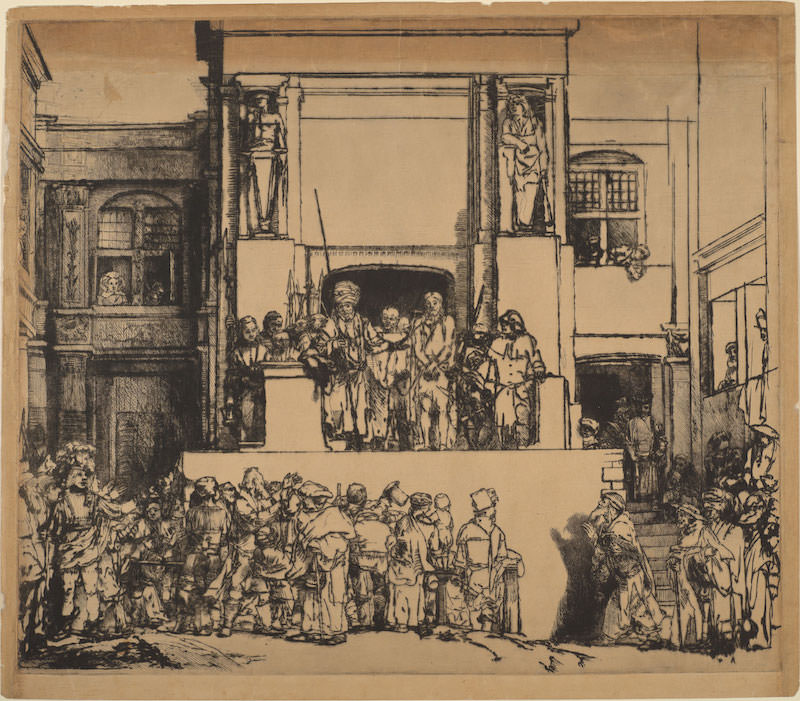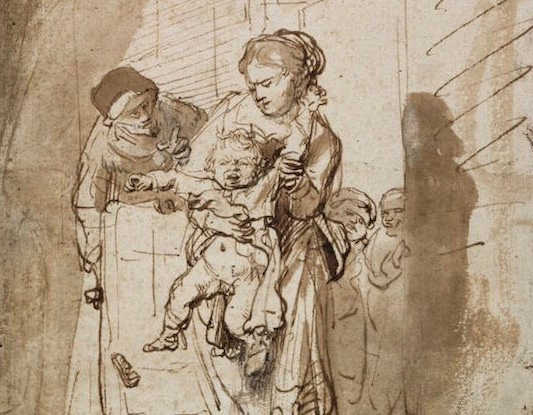
The Morgan Library and Museum is showing Rembrandt’s Judas Returning the Thirty Pieces of Silver and an assortment of etchings and preparatory studies in an exhibit it has titled Rembrandt’s First Masterpiece. Part of a private collection in Great Britain, it’s a rare treat for Judas to be exhibited, and rarer still for it to be in the United States. It’s well worth a trip to the Morgan.
Judas Returning the Thirty Pieces of Silver was painted in 1629 when Rembrandt was twenty-three years old. The title of the exhibit is based on the premise that this is the first painting by Rembrandt that demonstrates the traits that we associate with his mature style, such as the strong use of chiaroscuro and the expressive use of light. For me, the exhibit resonates with Rembrandt’s great humanity and the power of his visual expression achieved through composition and light. The studies for Judas that are included in the show testify to the deliberateness with which Rembrandt designed his paintings.
Rembrandt portrays a penitent Judas on his knees before the high priests in the temple. His hands are tightly clasped in a pleading gesture, his clothes torn open and his breast exposed, his scalp bleeds from tearing out his hair, his facial expression one of unimaginable woe and deep suffering. The thirty pieces of silver lay on the floor before him where he cast them. Judas’s eyes seem shut in agony, tears escaping them as he inclines his head toward the money that symbolizes his guilt. He is the very picture of remorse. The temple elders react with disgust, curiosity, shock, and perhaps from two at the very back, a little sympathy. The high priest looks away and holds his hand out in revulsion. To the left of the composition, a temple elder is seated in the foreground, his back to the viewer silhouetted by the light falling on the table in front of him. On that table is a large open book, presumably the Hebrew Bible, on which the strongest light of the painting falls. A cast shadow from this figure extends across the entire foreground. Just behind this cast shadow are the thirty pieces of silver in a pool of light. Moving left to right across the composition we come to Judas. He is not the brightest point in the painting; the strongest contrast brings our eye to the open book. However, the book is the beginning of a curvilinear flow that takes our eye from it along the bent backs of the two elders leaning forward to the standing elder with the tall hat, down along the high priest’s outstretched hand and then down along Judas’s back. The cast shadow in the foreground brings us back to the book where we start the visual journey again. Two large columns, one heavily decorated, provide some vertical stability.
To the far right we glimpse two men coming up a dimly lit stairwell. One of the figures appears older and bent as if the climb is a strain. Possibly, he is leaning forward to catch a glimpse of the drama going on ahead of him. The angle of his bent back creates an implied diagonal line to where Judas’s brown robe hangs off his arm, neatly knitting together the composition. That bent back manages to simultaneously create a compositional device that also lends human verisimilitude to the image.

Rembrandt designed the painting with radial balance. All the curvilinear lines flow to Judas. Most painters make the focal point the brightest point in the image, but Judas is half in darkness. Rembrandt is subtle and was perhaps using the light symbolically as well as expressively. The bible is the metaphorical source of light. Is the silhouetted elder in the foreground a barrier that partially excludes Judas from that divine light, or a simple pictorial device? Rembrandt designed the architecture of his image in blocks of light and dark, but he is able to manipulate the design for both visual and conceptual purposes. He used similar lighting scenario for The Supper at Emmaus painted during the same period. Rembrandt painted Christ silhouetted by a light that conceals his identity, though more from the viewer than his disciple. In both cases, the light has a strong visual impact, and also a narrative and thematic implication as well.
Rembrandt plays the fine rendered details like a melody over the rhythm of the larger chiaroscuro structure. The painting is only about 31 x 40 inches. The heads are relatively small, and the amount of detail he paints in the turban of the high priest is absolutely stunning. We may think of Rembrandt as a painter of painterly life-size portraits, but this exhibition demonstrates he was a master miniaturist as well. Also in the exhibit is his etching and drypoint Self Portrait in a Cap, Wide Eyed and Open Mouthed from 1630. I know this piece well from reproduction, but I had no idea it was only about 2 by 1½ inches. It is simply stunning. I think my expression looking at it must have mirrored his own.
Also in the exhibition is an etching Christ Disputing with the Doctors/Small Plate. It’s about 4 x 3 inches and has a remarkably similar composition to Judas Returning the Thirty Pieces of Silver. Hanging nearby is the Hundred Guilder Print. They demonstrate how Rembrandt sets his stage with light. Light and drama are hallmarks of Baroque painting, echoes of Caravaggio’s innovations spreading throughout Europe. What makes Rembrandt unique is he sees not only the dramatic visual possibilities of light, but he also understands the expressive potential. It was years after Judas before he fully realizes that potential, but the beginnings are there. The amount of emotional intensity expressed by Judas reveals Rembrandt the psychologist, the painter of the soul. Also in the exhibit are two states of his etching Christ Presented to the People from 1655. In the eighth state of the plate, Rembrandt removes the crowd in the foreground we see the first state and replaces them with two massive arches above the dungeon windows. This simplifies the foreground, putting far more of the dramatic emphasis on Christ. Rembrandt clearly designed his compositions with a keen awareness of the abstract arrangement of the shapes and values, but is equally aware of the narrative and dramatic implications of their placement.
The subject of Judas Returning the Thirty Pieces of Silver is another indication that Rembrandt is an unusual artist. It is a scene rarely depicted in art. Why did he choose it? Judas is not portrayed with disgust, hatred, or antipathy of any sort. He is not the villain. Rembrandt makes us feel sympathy for the sinner, one of the most reviled individuals in Christianity. It is a profound meditation on forgiveness and remorse created by an artist who lived in a time of both deep faith and sectarian warfare. The Crucifixion scene is usually the big subject for portraying the forgiveness of God. Rembrandt confronts people of faith with quite another scene, and the challenge of living by the words of their savior. Can they forgive the remorseful Judas?
Rembrandt was only twenty-three. It’s a very complex image on every level for such a young artist. He was far more educated than the typical artist of that period, and it comes through in a work like Judas. He designed his painting with a big idea in mind and found the visual language to serve that idea. It is not only the quality of painting and design that comes through in this work; it is the quality of his mind and the nature of his heart.
Rembrandt’s First Masterpiece continues through September 18, 2016 at the Morgan Library & Museum.






